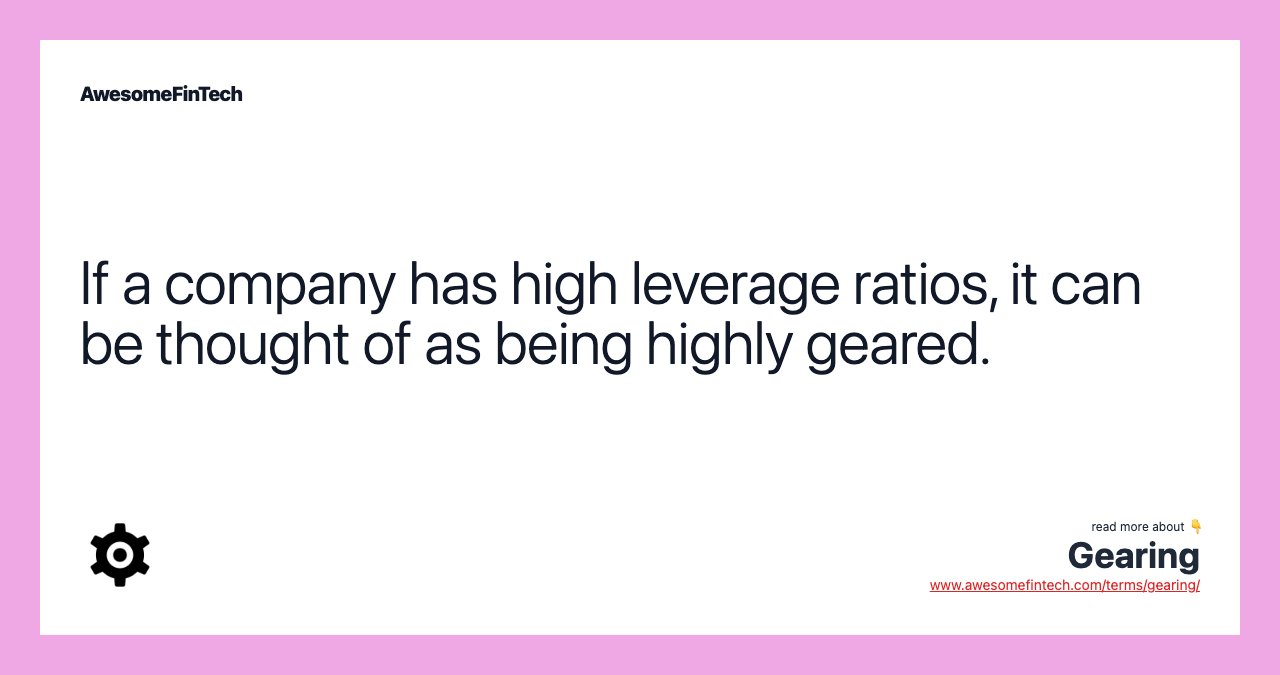Gearing
Gearing refers to the relationship, or ratio, of a company's debt-to-equity (D/E). 1:46 Gearing is measured by a number of ratios — including the D/E ratio, shareholders' equity ratio, and debt-service coverage ratio (DSCR) — which indicate the level of risk associated with a particular business. In general, a company with excessive leverage, demonstrated by its high gearing ratio, could be more vulnerable to economic downturns than a company that's not as leveraged, because a highly leveraged firm must make interest payments and service its debt via cash flows, which could decline during a downturn. Currently, XYZ Corporation has $2,000,000 of equity; so the debt-to-equity (D/E) ratio is 5x — \[$10,000,000 (total liabilities) _divided by_ $2,000,000 (shareholders' equity) _equals_ 5x\]. Gearing can be thought of as leverage, where it's measured by various leverage ratios, such as the debt-to-equity (D/E) ratio.

What Is Gearing?
Gearing refers to the relationship, or ratio, of a company's debt-to-equity (D/E). Gearing shows the extent to which a firm's operations are funded by lenders versus shareholders — in other words, it measures a company’s financial leverage. When the proportion of debt-to-equity is great, then a business may be thought of as being highly geared, or highly leveraged.



Understanding Gearing
Gearing is measured by a number of ratios — including the D/E ratio, shareholders' equity ratio, and debt-service coverage ratio (DSCR) — which indicate the level of risk associated with a particular business. The appropriate level of gearing for a company depends on its sector and the degree of leverage of its corporate peers.
For example, a gearing ratio of 70% shows that a company’s debt levels are 70% of its equity. A gearing ratio of 70% might be very manageable for a utility company — as the business functions as a monopoly with support from local government channels — but it may be excessive for a technology company, with intense competition in a rapidly changing marketplace.
Special Considerations
Gearing, or leverage, helps to determine a company's creditworthiness. Lenders may consider a business’s gearing ratio when deciding whether to extend it credit; to which a lender might add factors like whether the loan would be supported with collateral, and if the lender would qualify as a "senior" lender. With this information, senior lenders might choose to remove short-term debt obligations when calculating the gearing ratio, as senior lenders receive priority in the event of a business’s bankruptcy.
In cases where a lender would be offering an unsecured loan, the gearing ratio could include information about the presence of senior lenders and preferred stockholders, who have certain payment guarantees. This allows the lender to adjust the calculation to reflect the higher level of risk than would be present with a secured loan.
Gearing vs. Risk
In general, a company with excessive leverage, demonstrated by its high gearing ratio, could be more vulnerable to economic downturns than a company that's not as leveraged, because a highly leveraged firm must make interest payments and service its debt via cash flows, which could decline during a downturn. On the other hand, the risk of being highly leveraged works well during good economic times, as all of the excess cash flows accrue to shareholders once the debt has been paid down.
Example of Gearing
As a simple illustration, in order to fund its expansion, XYZ Corporation cannot sell additional shares to investors at a reasonable price; so instead, it obtains a $10,000,000 short-term loan. Currently, XYZ Corporation has $2,000,000 of equity; so the debt-to-equity (D/E) ratio is 5x — [$10,000,000 (total liabilities) divided by $2,000,000 (shareholders' equity) equals 5x]. XYZ Corporation definitely would be considered highly geared.
Related terms:
Accounting
Accounting is the process of recording, summarizing, analyzing, and reporting financial transactions of a business to oversight agencies, regulators, and the IRS. read more
Capital Gearing
Capital gearing refers to the amount of debt a company has relative to its equity, known as financial leverage in the United States. read more
Capitalization Ratios
Capitalization ratios are indicators that measure the proportion of debt in a company’s capital structure. Capitalization ratios include the debt-equity ratio, long-term debt to capitalization ratio, and total debt to capitalization ratio. read more
Debt-to-Equity (D/E) Ratio & Formula
The debt-to-equity (D/E) ratio indicates how much debt a company is using to finance its assets relative to the value of shareholders’ equity. read more
Debt-Service Coverage Ratio (DSCR)
In corporate finance, the debt-service coverage ratio (DSCR) is a measurement of the cash flow available to pay current debt obligations. read more
Gearing Ratio
The gearing ratio is a measure of financial leverage that indicates the degree to which a firm's operations are funded by equity versus creditor financing. read more
Highly Leveraged Transaction (HLT)
A highly leveraged transaction (HLT) is a bank loan to a company that already carries a huge debt load. read more
Recession
A recession is a significant decline in activity across the economy lasting longer than a few months. read more
Risk
Risk takes on many forms but is broadly categorized as the chance an outcome or investment's actual return will differ from the expected outcome or return. read more
Solvency Ratio
A solvency ratio is a key metric used to measure an enterprise’s ability to meet its debt and other obligations. read more